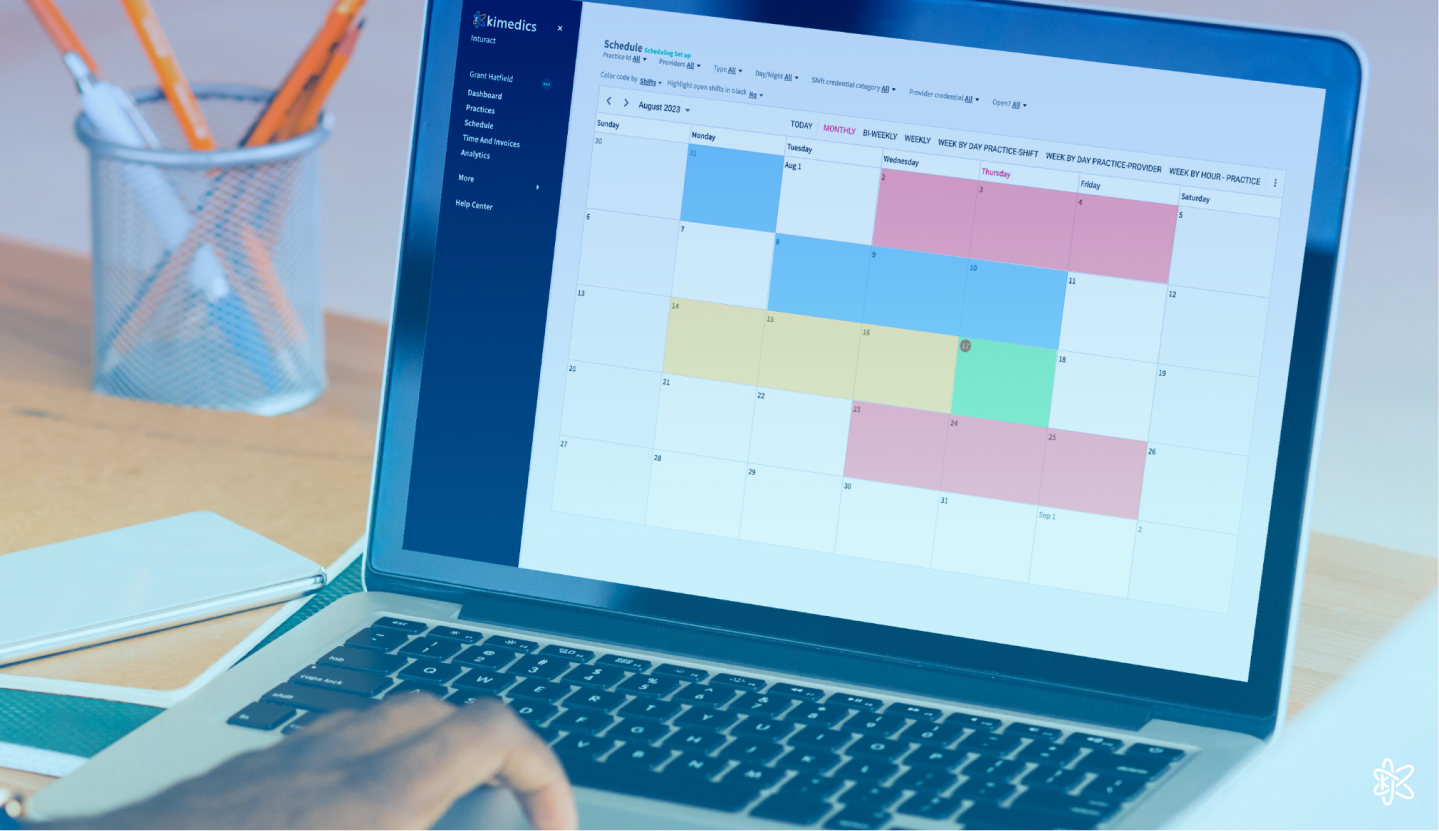We’ve all been there. We’ve double booked a provider, scheduled someone before they are privileged or enrolled, or we’ve missed a start date. What happens next? We end up paying bonuses to cover the schedule and/or staff is left scrambling to fill shifts. As technicians and doctors scramble to address patient care, we wonder, “Isn’t there a better way to handle healthcare staff scheduling?”
Efficient staff scheduling plays a crucial role in ensuring smooth operations and top-notch patient care in the healthcare industry. That said, healthcare staff scheduling comes with its share of challenges. With this in mind, below we'll take a look at the importance of streamlined healthcare staff scheduling and the obstacles healthcare organizations just like yours often face when trying to manage scheduling.
Our aim with this post is to equip you with five practical tips to optimize your staff scheduling and enhance efficiency. Additionally, we'll provide a helpful healthcare staff scheduling template for your reference. With these insights, you can take your scheduling game to the next level, and create a more coordinated workforce. Let's unlock the secrets to seamless healthcare staff scheduling!
Why is Efficient Healthcare Staff Scheduling So Important?
Efficient staff scheduling in healthcare is a hot button issue because it ensures the right number of qualified staff are available to see patients when they are needed. When schedules are aligned and staff needs are met, the result is better patient care and reduced costs. Unfortunately, healthcare staff scheduling does pose challenges. For example, managing complex shift patterns, accommodating staff preferences, and avoiding under/overstaffing to name a few.
Our top five practical tips to streamline healthcare staff scheduling are:
- Utilize Collaborative Scheduling Software
- Optimize Staff Availability and Preferences
- Implement Effective Communication Channels
- Embrace Flexible Scheduling Models
- Continuously Monitor and Adjust Schedules.
Now that you know what our top tips are, let’s break them down further so you can take your healthcare staff scheduling to the next level!
Tip 1: Utilize Collaborative Scheduling Software
Collaborative scheduling software offers several benefits to healthcare organizations. Enhanced communication and coordination among staff, improved transparency of schedules, and simplified shift swapping and coverage requests are just a few reasons to take advantage of software.
When considering scheduling software for healthcare settings, it’s important to look for the following key features:
- Real-time updates
- Mobile accessibility
- Customizable workflows
- Integration with HR and payroll systems, and
- Industry regulations compliance.
One such collaborative software is Kimedics which significantly improves accuracy and efficiency in staff scheduling. It accomplishes this task by automating the process, reducing errors, and providing real-time data on staff availability and credentials. With its mobile-first design and vendor partner-neutral approach, it streamlines operations and fosters seamless collaboration among internal teams and third-party partners.
Tip 2: Optimize Staff Availability and Preferences
Understanding staff availability and preferences is key if your goals are efficient healthcare staff scheduling, ensuring the right personnel are assigned to shifts, and avoiding scheduling conflicts. Implementing strategies to collect and manage staff availability data involves using scheduling software to gather real-time updates, setting up regular communication channels to receive preferences, and creating a centralized database for easy access.
A quick note about schedule equity:
Scheduling equity is a crucial aspect in healthcare staff scheduling, and it has become a significant discussion point in many healthcare organizations. It emphasizes the need to ensure fairness in assigning shifts and avoiding favoritism or bias. The goal is to ensure that the same individuals are not consistently assigned to undesirable shifts, such as nights, weekends, holidays, or on-call duties.
That’s where scheduling algorithms and software like Kimedics really shines. To incorporate staff preferences while maintaining fairness, healthcare organizations can use scheduling algorithms that prioritize preferences within set guidelines. Additionally, it can alleviate schedule equity issues by:
- Flagging capacity limits,
- Managing minimum shift requirements, and
- Ensuring equitable distribution of less desirable shifts.
The end result of embracing schedule equity is that it promotes a balanced workload, prevents burnout, and fosters a positive work environment. Ultimately you’ll experience improved staff satisfaction and better patient care. Healthcare organizations should prioritize schedule equity as part of their workforce management strategy to create a supportive and equitable scheduling environment for all employees.
Sharing important information for someone's first shift can also be critical for a smooth onboarding process, and Kimedics' shift notes and timesheet notes enable seamless communication and feedback loops between providers and management.
Tip 3: Implement Effective Communication Channels
Seamless communication is also vital in healthcare staff scheduling. Just a few reasons why you need efficient communication are:
- It ensures efficient coordination,
- Reduces scheduling errors, and
- Helps you promptly address any changes/issues that could come up when scheduling.
Just a few tools and platforms you could use for scheduling coordination include messaging apps like Slack, collaboration platforms like Microsoft Teams, and email systems with read receipts and delivery confirmations. However, it’s important to note that all of those clunky platforms can lead to a lot of disconnect. The biggest reason for this is that doctors only use personal emails because they can work across multiple groups or companies. Even if you assigned them an organization specific email address, they likely won’t open work emails. Using software a good WRM eliminates a lot of the bottlenecks that occur in healthcare staff scheduling. More on that in a moment.
The bottom line is that you must foster clear and timely communication among staff members, establish regular update meetings, use real-time messaging for urgent matters, encourage open communication channels, and ensure that all staff members are familiar with the chosen communication tools and protocols. This way scheduling issues become a thing of the past, and appointments don’t fall through the cracks.
Tip 4: Embrace Flexible Scheduling Models
Flexible scheduling in healthcare offers several advantages including, but not limited to:
- Improved work-life balance for staff
- Increased job satisfaction
- Better patient coverage, and
- Enhanced adaptability to fluctuating patient demands.
What do different types of flexible scheduling models look like?
- Self-scheduling (i.e. staff can choose their shifts), and
- Float pools (i.e. staff can work in different departments based on need).
To effectively implement and manage flexible scheduling options it’s important to establish clear guidelines and policies, ensure fair distribution of shifts, and provide adequate training for staff. Additionally, two important things to consider are (1) Cross credentialing across facilities so you have a deep roster to minimize risk of sick leave, turnover or other unexpected team absences, and (2) Privileging management ensuring privilege is up to date to best leverage team members across locations. Accomplishing all of this and more is made easier when you use collaborative scheduling software to streamline the process and maintain accurate records.
Tip 5: Continuously Monitor and Adjust Schedules
Schedule monitoring and adjustments must be managed on a regular basis in healthcare staff scheduling. Doing so helps healthcare organizations to adapt to changing demands, ensure optimal staffing levels, and maintain high-quality patient care.
Key metrics to track and analyze for effective scheduling management include, but again are not limited to:
- Staff utilization rates
- Overtime and labor costs
- Patient-to-staff ratios
- Staff satisfaction
- Turnover rates, and
- % Third Party or Agency vs. Internal
To optimize staff utilization, it’s a good idea to use data-driven insights to identify scheduling inefficiencies, implement predictive modeling for future staffing needs, and maintain open communication with staff to accommodate their availability and preferences when making schedule modifications. For example, using Kimedics' real-time data and advanced analytics can aid in making informed decisions to continuously improve scheduling practices.
Conclusion and Next Steps
In this post, we have explored five valuable tips to streamline healthcare staff scheduling:
- Utilize Collaborative Scheduling Software
- Optimize Staff Availability and Preferences
- Implement Effective Communication Channels
- Embrace Flexible Scheduling Models
- Continuously Monitor and Adjust Schedules.
Efficient scheduling is essential for ensuring top-notch patient care and boosting staff satisfaction, leading to better outcomes and a positive work environment. If you want to make the task of healthcare staff scheduling an easier one, we highly recommend Kimedics Healthcare Workforce Solutions.
Kimedics is a healthcare workforce management platform that streamlines operations, so teams can focus on patient care. It's mobile-friendly, designed specifically for healthcare, and offers real-time data and analytics. With vendor-friendly features, it allows easy collaboration with partners. Say goodbye to static spreadsheets, clunky (and disconnected!) communication and/or scheduling platforms, and hello to efficiency!
As a helpful resource, below you’ll find a downloadable healthcare staff scheduling template that enables you to apply the tips we’ve shared here, and create a well-coordinated and efficient workforce. We think you will find that this template will ultimately benefit both patients and staff alike.
Ready to make your healthcare staff scheduling more efficient? Click here to book a demo!
Basic Healthcare Scheduling Template
Healthcare Staff Scheduling Template
|
Week: [Insert Week Number or Date Range] |
|||||
|
Day/Date |
Shift 1 |
Shift 2 |
Shift 3 |
Shift 4 |
Shift 5 |
|
Monday |
[Name] |
[Name] |
[Name] |
[Name] |
[Name] |
|
Tuesday |
[Name] |
[Name] |
[Name] |
[Name] |
[Name] |
|
Wednesday |
[Name] |
[Name] |
[Name] |
[Name] |
[Name] |
|
Thursday |
[Name] |
[Name] |
[Name] |
[Name] |
[Name] |
|
Friday |
[Name] |
[Name] |
[Name] |
[Name] |
[Name] |
|
Saturday |
[Name] |
[Name] |
[Name] |
[Name] |
[Name] |
|
Sunday |
[Name] |
[Name] |
[Name] |
[Name] |
[Name] |
|
Legend: |
||
|
Shift 1 |
[Shift Timing] |
[Shift Description] |
|
Shift 2 |
[Shift Timing] |
[Shift Description] |
|
Shift 3 |
[Shift Timing] |
[Shift Description] |
|
Shift 4 |
[Shift Timing] |
[Shift Description] |
|
Shift 5 |
[Shift Timing] |
[Shift Description] |
|
...: [Add More Shifts as Needed] |
||
Note: Insert the names of staff members assigned to each shift.


